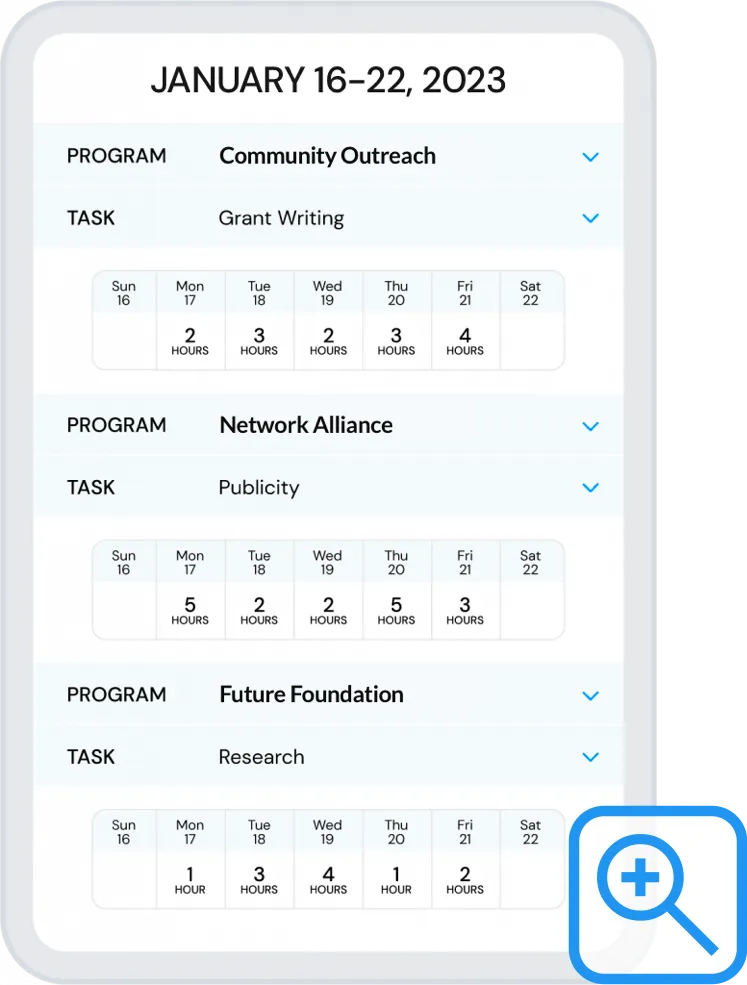by Using Time Tracking, Payroll, and ERP Systems Together
Grants can be a great way to fund your nonprofit and further your mission.
But they also come with extra administrative burdens.
According to the Council of Nonprofits, 72% of all nonprofits indicate that grant reporting requirements are complex and time-consuming. The issue compounds the larger your nonprofit organization grows, as your programs begin to receive funding from multiple sources, each with its own requirements.
The key to streamlining your grant compliance processes lies in your internal controls-how you allocate, document, and report on your grant expenditures. But the challenge is the data you need lives in several different systems, and there isn't a singular way to connect these tools in your stack, via data exports, manual processes, or integrations. The typical result? A suboptimal workflow that is error-prone and costs a tremendous amount of valuable human capital to maintain. And, in the worst-case scenario, may even result in grant noncompliance.
In this article, we'll outline the most common way nonprofits manage their grants, what challenges arise, and how to improve operations by creating the ideal internal controls.
Where Nonprofits Waste Time and Frustrate Employees in the Grant Compliance Process

After working closely with customers and partners on grant compliance processes over the last 20 years, ClickTime's Customer Success Team has found six distinct areas where organizations waste time and frustrate employees.
1. Manually Adding the Grant to Their ERP & Payroll Systems
Many nonprofits kickstart the compliance process when the Finance Team adds a grant to their ERP system. The team creates budget timelines and plans employee labor allocations.
Employees then attempt to log time to the new grant in their payroll software. Unfortunately, the grant doesn't appear immediately in their payroll system until HR sends an email asking their payroll provider to provision the grant in the system. This delay can create confusion and additional work for Finance, HR, and payroll employees.
2. Failing to Collect Accurate Timesheets On Time

Getting employees to submit accurate timesheets on time is a significant issue that nonprofits face in the grant compliance process.
If employees find the payroll platform's timesheets unintuitive, it can lead to errors and mistakes. For example, an employee may log time to the wrong program or grant, which then needs to be corrected by managers later. Unintuitive codes and confusing presentations in the payroll platform often cause this. Payroll timekeeping systems were designed for a different purposes, so the interface is confusing, high friction, and difficult to use in grant and project accounting scenarios.
Additionally, with no oversight into their workforce's timesheet completion during a pay period, managers are left in the dark as to whether their employees are actively logging accurate data. Chasing down incomplete timesheets becomes a huge management hassle. The right tool makes adoption and visibility for managers a breeze; you can know whose timesheets are filled out, accurately, and what people have logged time to quickly and seamlessly.
3. Lacking Visibility Into Grant Spend Between Payroll Periods
Most finance organizations have to wait until the end of the payroll period to understand the burndown for specific grants. There is little to no understanding of what is transpiring in game time. While this might be OK some of the time, when you near monthly or year-to-date thresholds, this can result in significant budget variance from plan, which may require one of several methods for remediation that can be costly or expensive to the organization to go back and correct time entries, if it is even allowed.
4. Manually Performing Cost Allocations
Performing labor cost allocations is time-consuming for many nonprofits that do the calculations manually. This process often involves exporting time reports, then creating excel formulas to determine the percentage of time each employee spent on programs and grants. Often, this is a lengthy and error-prone process.
5. Reclassifying Incorrect Time Entries
Once timesheets are submitted, validating or reclassifying time entries can be tedious. If there are errors in time entries, it can require significant effort to correct and recategorize labor cost allocations. This is typically done in one of two ways:
- The finance team must change the time entries themselves, line by line.
- Or the finance team must contact managers, who must chase down employees to verify where their time was truly spent.
This process can be especially challenging if the organization has federal grants with stringent regulations that require all changes to be captured in an audit log.
6. Being Unprepared for an Audit
Finally, preparing for an audit can be stressful for nonprofits. If the organization's systems of record don't include the ability to verify all records and changes, it can be time-consuming to gather the necessary documentation for auditors. Very few timekeeping systems have the requisite change controls tracking all events from submission to approval, to any ex post facto changes. Failing an audit can put critical funding sources at risk; it's imperative to have an insurance policy so that you can demonstrate compliance.
What Role Each of Your Software Systems Should Play in Grant Compliance

When assembling your tech stack for grant compliance, don't forget to think through it from a systems architecture and design perspective. Consider what role each type of software should play in an orchestrated fashion. And when assembling your dream team - consider which system is the master record for each critical piece of time, payroll, and cost data; as well as, how that data will flow and in what direction and cadence.
Time Tracking

The goal of great time tracking software is to provide a simple, easy-to-use interface to accurately capture time spent on various categories. Time may be tracked directly to grants, or time may be tracked to projects, programs, or other named categories that might be intuitive to the end user. The more clear the selections, the less errors and reclassifications. In some cases, employee time may get further subdivided and allocated to several different funding sources after the fact. This choice depends on the nonprofit's goals for ease of use, the complexity of the relationship between various grants and programs, and the organization's process for performing allocations. At the end of the day, the cloud time platform is the system of record for time and is used to derive the percent of the employee's total time spent on each subcategory.
Great time software offers an intuitive user interface that provides the best employee experience for tracking time. It also allows managers and accounting staff to see overall completion, so they can be sure that when they are running numbers the data is complete and accurate, and no timesheets are missing that might throw off payroll or budget allocations.
Additionally, time-tracking software acts as the bridge between ERP and payroll solutions. The software is designed to be easily integrated with both platforms, feeding them with the data they need to perform their allocations and calculations.
ERP (Enterprise Resource Planning)
Enterprise resource planning software enables nonprofit organizations to manage and track their financial resources, including grant funding, in a centralized and organized manner. Nonprofits use ERPs in grant financial planning, cost allocation, and reporting compliance. These software act as the "central hub" of a nonprofit's financials, collecting data from payroll and time tracking systems. ERPs help organizations ensure that they're using grant funds appropriately and complying with grant reporting requirements.
While ERPs are a great system of record for accounting, they aren't ideal for tracking time, as they fall short in providing the customizability and complexity required to capture all dimensions. They also lack some of the usability features that can optimize ease of use for all roles, limiting the efficacy of adoption. Lastly, timesheets in ERP will lack actionable insights that feed powerful daily or weekly analysis and planning, like displaying goals to your end users regarding where they should be spending their time.
Payroll Software
Payroll software helps grant recipients maintain accurate and complete records of employee wages. This information is often required to be reported to the grantor as part of the grant agreement. Payroll software also helps grant recipients track and record employee benefit costs and other payroll-related expenses, such as taxes and insurance, ensuring that these costs are accurately accounted for in grant financial reports. Because of legalities surrounding time off, payroll is often a system of record for time off spent and remaining balances.
The direct and indirect costs of employees found in payroll impact budgets across the entire organization. However, these costs need to be distributed to grants, and generally fractionally based on how employees spend their time. Payroll is the system of record for costs and for time off at the end of the day, but because it's not a purpose-built or flexible tool for time capture, trying to use payroll for time collection can be severely limiting and result in tremendous administrative overhead. Trying to use one system for both can be costly for the organization.
How to Streamline Financial Reporting by Using Your Software Correctly

Now that we know what role each software platform should play in grant compliance, let's take a look at each of the steps involved with financial reporting and learn how to use the software in unison.
Integrate ERP with Time Tracking to Automatically Provision Grants
When a new grant is activated in your ERP system, it should automatically be available in your timekeeping software. By integrating your ERP system with your time-tracking solution, new grants are immediately provisioned in your time-tracking system. This ensures that employees can track time to the appropriate grants immediately, reducing the risk of errors.
Use Time Tracking Software to Guarantee Accurate Timesheet Completion
Ensuring that employees complete their timesheets accurately and on time is crucial for streamlining grant compliance. Using a dedicated timesheet platform makes employees more likely to log their hours to the correct grants, helping prevent downstream errors. Time tracking software comes with intuitive dropdown selectors that allow employees to easily select the appropriate grants without knowing any grant codes. Proper timesheets will also ask employees to authenticate each timesheet before submission-a step that auditors love.
Time tracking software gives managers real-time access to reports on timesheet completion, allowing them to identify late or incorrect time entries proactively. This managerial oversight helps validate data before it reaches the ERP system.
Additionally, with a dedicated time tracking platform, employees can see targets for how many hours they should spend on each program via their timesheet dashboard. Viewing assigned hours helps employees prevent unexpected budget variances later during the labor cost allocation process.
Monitor Grant Burndown Between Payroll Periods Using Time Tracking Software with Robust Reporting Capabilities

Monitoring grant burndown in between payroll periods is crucial for optimizing grant funds. By doing so, your team will prevent employees from working on a grant with depleted funds, avoiding any unwelcome surprises about the month's progress.
Using time-tracking software, your Grant Managers and Finance Team can monitor work progress and ensure that employees follow the plan. Proactive monitoring allows teams to make adjustments before running payroll and sending labor hours to the ERP system.
By estimating payroll allocations before the end of a pay period, your team can effectively manage labor costs and maximize the use of grant funds.
Automatically Allocate Labor Costs in Your ERP System
The most common way to perform labor cost allocations is by integrating your payroll, time tracking, and ERP systems. When you integrate the three systems, ERP will have all the data it needs to perform labor cost allocations, specifically:
- Actual employee costs, supplied by your payroll provider.
- The number of employee labor hours spent on each program, as well as employee time off hours, supplied by your time tracking system.
From there, your ERP system will automatically intake or produce labor costs across your various funding sources.
While this is a logical way to use the three systems together to distribute labor costs, many nonprofits also use other configurations depending on their unique requirements, vendor selections, and allocation rules. Some additional configurations include:
- Sending time tracking data to the payroll system, which provides an export to the general ledger.
- Manually exporting time and payroll data, and combining them in a workbook prior to importing to ERP.
- Sending time and payroll data to the ERP independently, and then applying rule sets and logic within the ERP (like Intacct's Dynamic Allocations) to automatically divvy up the time spent on each program across its various funding sources.
No matter what your preferred allocation method is, the most important step is eliminating unnecessary eliminating avoidable errors that arise from poor user interfaces, manual data entry, or disconnected workflows that depend on human updates.
Use All Three Systems to Provide Raw Data for Audits
Submitting financial reports for grant audits is relatively easy when using payroll, ERP, and time-tracking systems together. By exporting data from these systems, the necessary financial information can be easily compiled and organized into the required format for the grant audit.
First, the payroll system can provide detailed information on employee salaries, benefits, and any additional expenses related to the grant project.
Next, the ERP system can provide information on the costs of goods and services associated with the grant project. These costs can include materials, supplies, and other expenses necessary for completing the grant project.
Finally, the time tracking system can provide detailed information on the amount of time and resources allocated to the grant project. With built-in audit trails and employee timesheet authentications, auditors will have all the raw data they need to validate the authenticity of your nonprofit's effort.
Spend More Time On Your Mission, Not On Grant Compliance

By correctly using time tracking, payroll, and ERP systems in your nonprofit organization's grant compliance process, you can make a significant difference in the efficiency and accuracy of your operations.
And by providing your employees with easy-to-use tools to track time, manage payroll, and allocate costs, you can eliminate potential errors and inconsistencies, ensuring that you meet all grant requirements.
Furthermore, by integrating these systems, you can gain valuable insights into your organization's financial and operational data, allowing you to make informed decisions and optimize your grant compliance efforts.
With the right technology, you can make grant compliance a breeze for your employees and focus on delivering impactful programs and services to your community.





